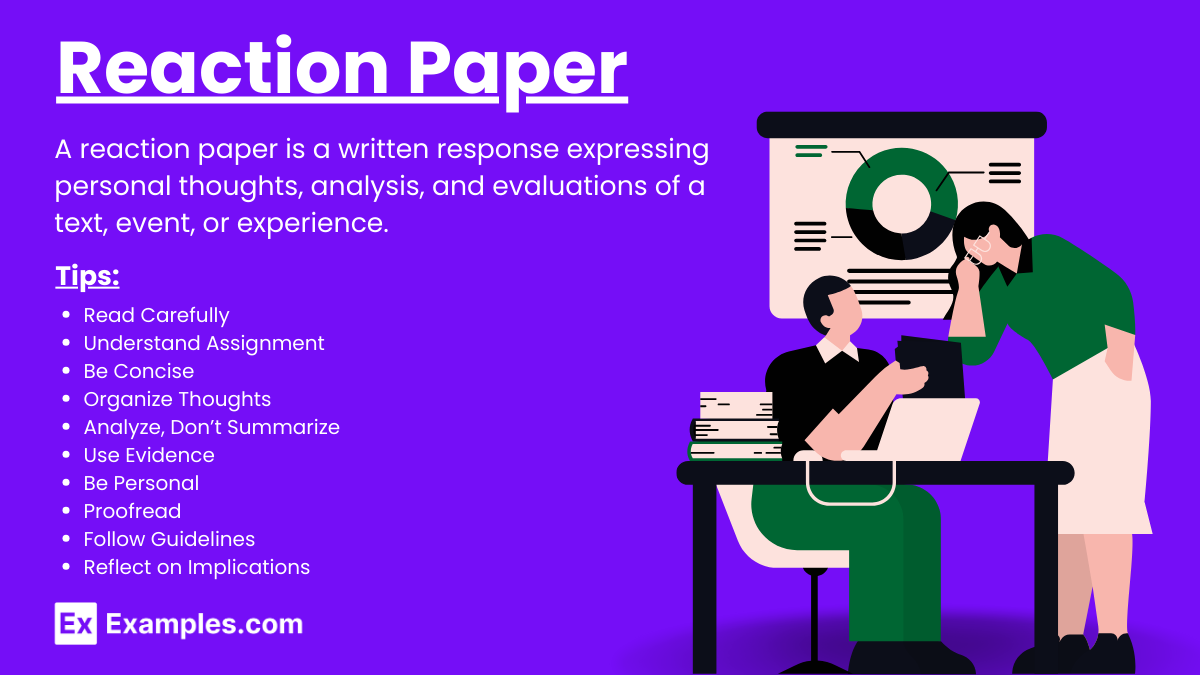15+ Reaction Paper Examples
A reaction paper is an academic assignment where students share their personal response and analysis of a text, event, or experience. It requires not only summarizing the content but also reflecting on its impact and significance. This type of paper allows students to express their thoughts, connect ideas, and engage in critical thinking, making it a valuable tool for deepening understanding and fostering intellectual growth.
What is a Reaction Paper?
A reaction paper is an academic assignment where students provide a personal response and analysis of a text, event, or experience. It involves summarizing the content, reflecting on its significance, and expressing personal insights. This type of paper encourages critical thinking, enhances writing skills, and deepens understanding of the subject matter.
Reaction Paper Format
A reaction paper is a written assignment that requires a personal response to a text, event, or experience. It combines summary, analysis, and personal reflection. Here is a format you can follow to structure your reaction paper effectively:
- Title Page:
- Title of the reaction paper
- Your name
- Course name and number
- Instructor’s name
- Date
- Introduction:
- Summary:
- Briefly summarize the content you are reacting to
- Highlight the main points or arguments
- Keep this section concise and objective
- Analysis and Reaction:
- Analyze specific aspects of the content (themes, characters, arguments, etc.)
- Discuss your reaction to these aspects
- Support your reactions with examples from the content
- Explain why you reacted the way you did (personal experiences, beliefs, etc.)
- Personal Reflection:
- Reflect on how the content relates to your personal experiences or beliefs
- Discuss what you learned or how your perspective has changed
- Mention any questions or thoughts that arose while engaging with the content
- Conclusion:
- Summarize your main points and reactions
- Restate your thesis or overall impression
- Provide closing thoughts or implications for the future
- References:
- Cite any sources you referenced in your paper
- Use the appropriate citation style (APA, MLA, Chicago, etc.)
Example of Reaction Paper Outline
Title Page
- Title: Reaction to “The Great Gatsby”
- Name: Jane Doe
- Course: English Literature 101
- Instructor: Prof. John Smith
- Date: May 17, 2024
Introduction
- Subject: “The Great Gatsby” by F. Scott Fitzgerald
- Context: A classic novel exploring the American Dream in the 1920s
- Thesis: “The Great Gatsby” offers a compelling critique of the American Dream, revealing its inherent flaws and the emptiness of material success.
Summary
- Main Points: Overview of the plot, main characters (Jay Gatsby, Nick Carraway, Daisy Buchanan), and key themes (wealth, love, aspiration).
Analysis and Reaction
- Theme Analysis: The illusion of the American Dream
- Reaction: Felt a sense of disillusionment
- Support: Gatsby’s tragic end and unfulfilled dreams
- Character Analysis: Jay Gatsby’s complexity
- Reaction: Sympathetic yet critical
- Support: His genuine love for Daisy versus his unethical means of achieving wealth
- Personal Connection: Reflections on modern aspirations and materialism
Personal Reflection
- Personal Experiences: Comparisons with current societal values
- Learning Outcome: Realization of the dangers of prioritizing wealth over genuine human connections
- Questions: How do contemporary views on success compare to those in the 1920s?
Conclusion
- Summary: Recap of main reactions and analysis
- Restated Thesis: “The Great Gatsby” remains relevant in its critique of the American Dream
- Closing Thoughts: Importance of balancing material aspirations with personal integrity and relationships
References
- Fitzgerald, F. S. (1925). The Great Gatsby. Charles Scribner’s Sons.
- Any additional sources referenced in the analysis
Reaction Paper Examples
- Reaction Paper to a Book
- Reaction Paper to an Article
- Reaction Paper to a Movie
- Reaction Paper to a Lecture
- Reaction Paper to an Event
Reaction to a Book
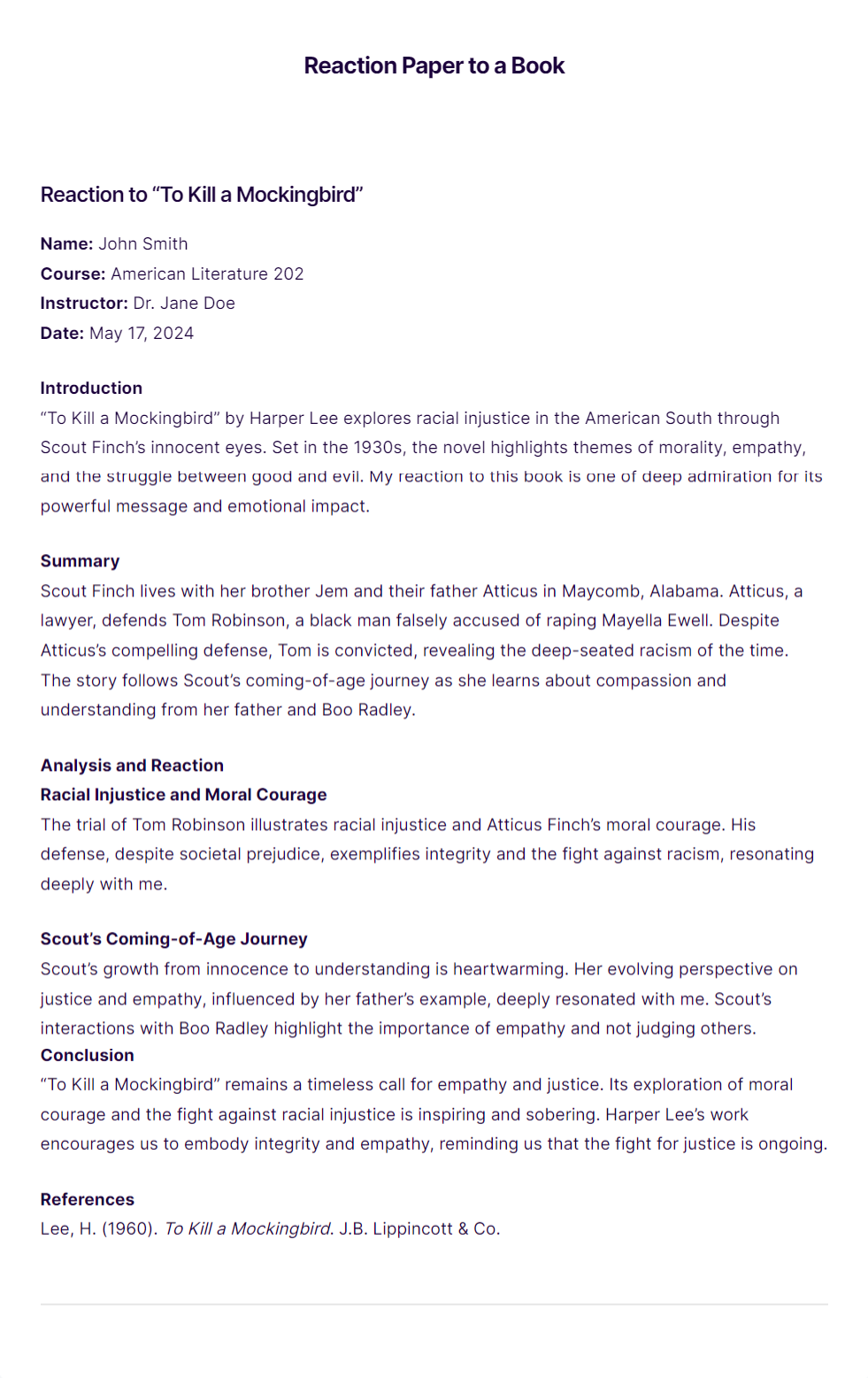
Reaction to an Article
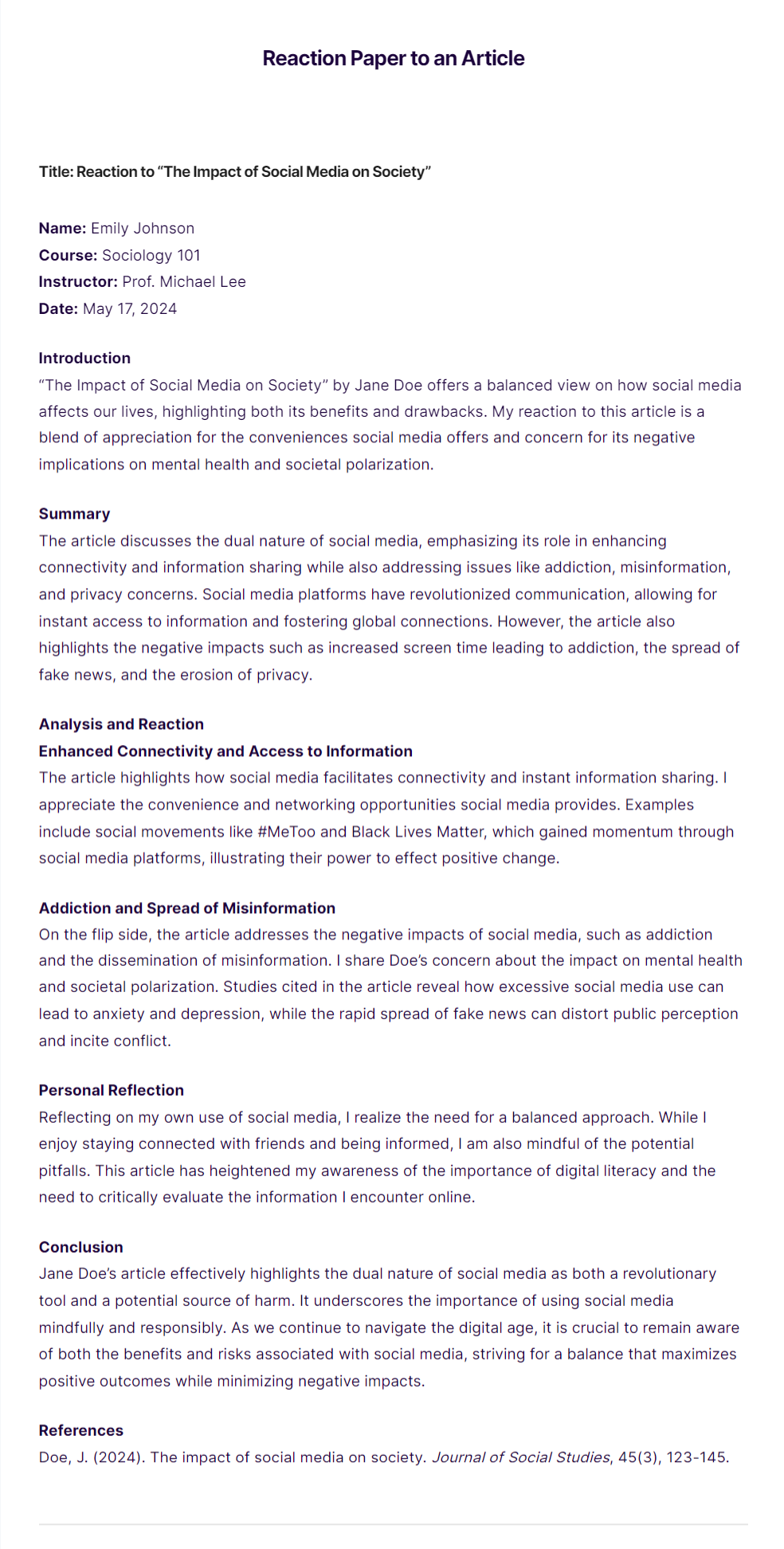
Reaction to a Movie
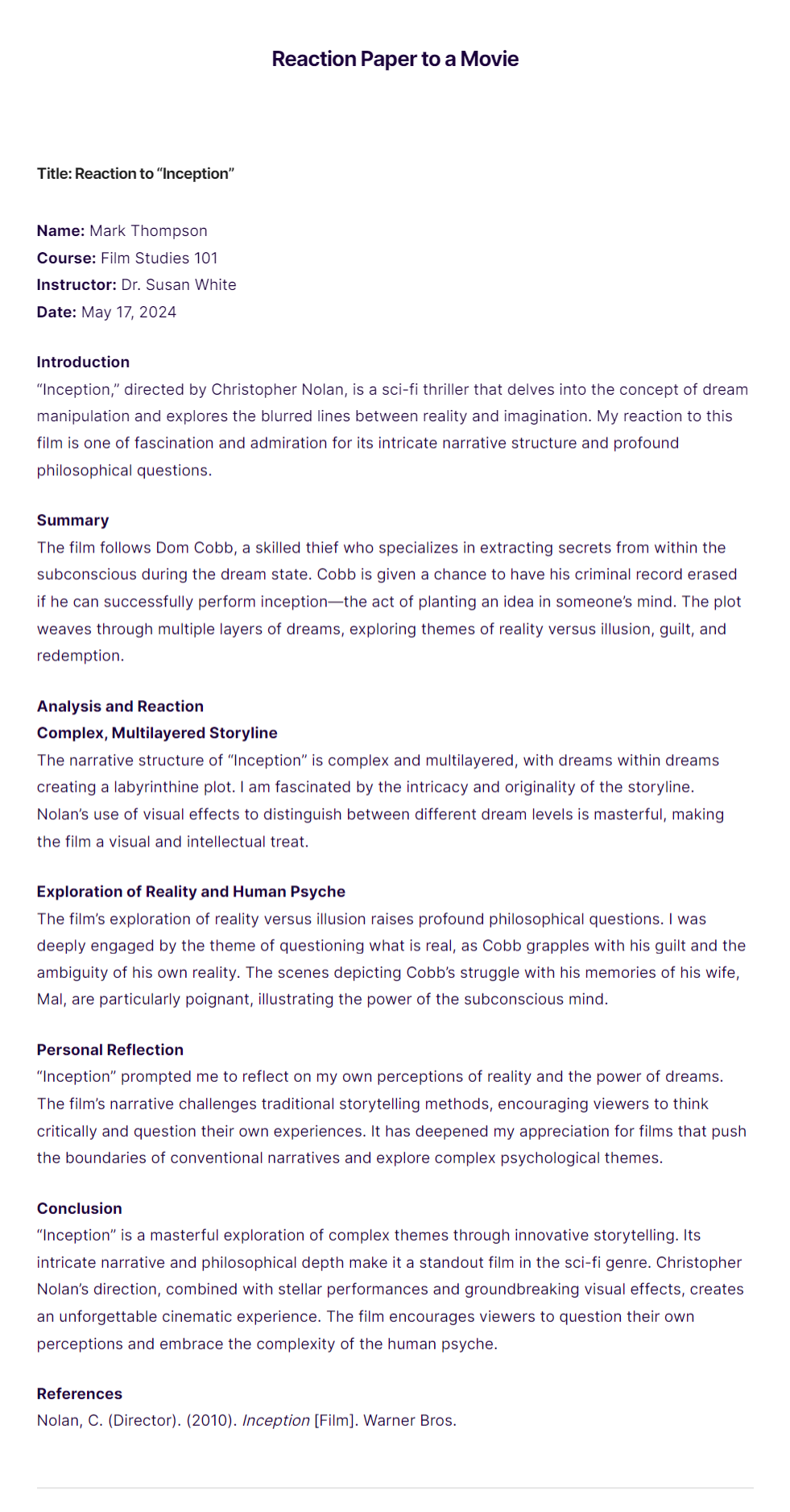
Reaction to a Lecture
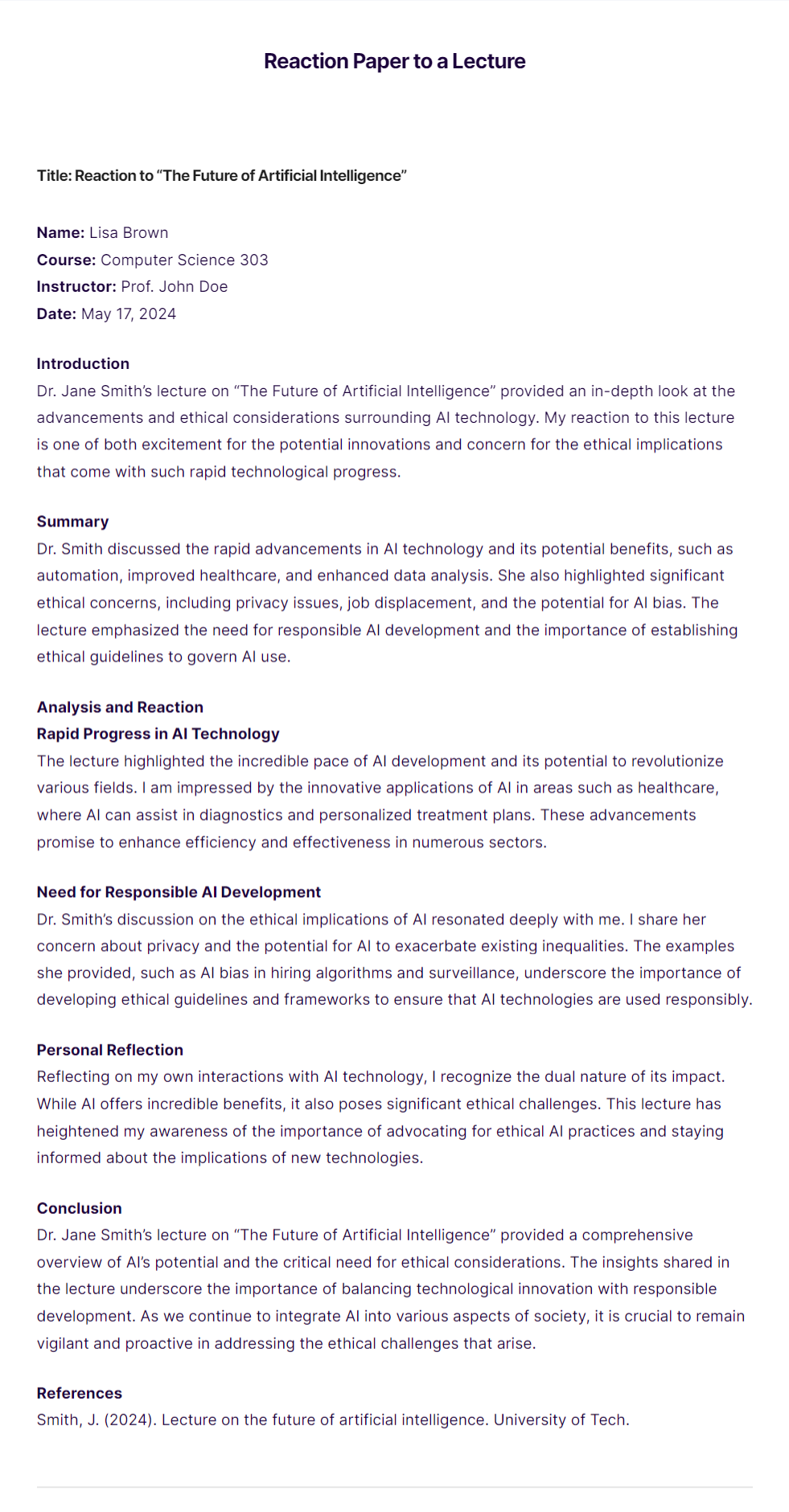
Reaction to an Event
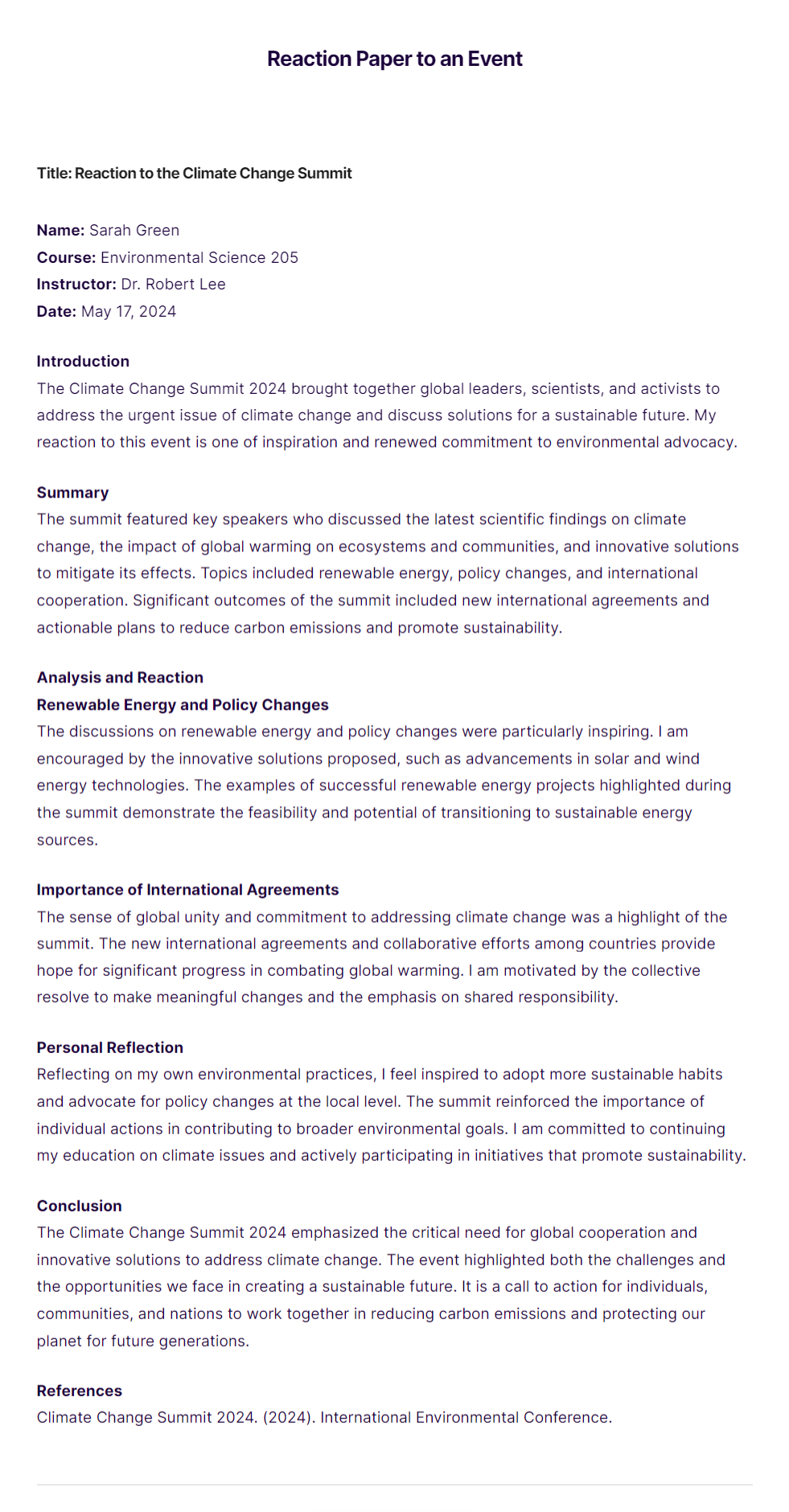
Reaction Paper Examples for Students
A reaction paper is a written assignment where students express their thoughts and opinions on a particular text, event, or experience. This type of writing allows students to critically analyze the subject and articulate their personal reflections. Below are some examples of reaction papers for various subjects to guide students in writing their own.
Reaction Paper on a Book
Title: Reaction to “To Kill a Mockingbird” by Harper Lee
Introduction
“To Kill a Mockingbird” by Harper Lee is a profound novel that addresses the serious issues of racial injustice and moral growth in the American South. The story is narrated by Scout Finch, a young girl whose father, Atticus Finch, serves as a moral hero and a model of integrity.
Summary of the Book
The novel is set in the 1930s in the fictional town of Maycomb, Alabama. Atticus Finch, a lawyer, is defending Tom Robinson, a black man falsely accused of raping a white woman, Mayella Ewell. Through Scout’s eyes, the reader witnesses the prejudice and racism that pervade the town.
Personal Reaction
Reading “To Kill a Mockingbird” was an eye-opening experience. The character of Atticus Finch particularly resonated with me due to his unwavering commitment to justice and equality. The novel’s portrayal of racism and social injustice made me reflect on current societal issues and the importance of standing up for what is right.
Analysis
Harper Lee’s narrative technique, using a child’s perspective to tackle serious topics, effectively highlights the innocence lost in the face of prejudice. The moral lessons imparted through the characters of Atticus and Scout underscore the importance of empathy and understanding in combating social injustice.
Conclusion
“To Kill a Mockingbird” is more than just a novel; it is a powerful call for moral courage and social change. It has inspired me to be more conscious of the injustices around me and to take a stand against them.
Reaction Paper on a Movie
Title: Reaction to “The Pursuit of Happyness”
Introduction
“The Pursuit of Happyness” is a biographical drama film based on the life of Chris Gardner, a man who rises from homelessness to become a successful stockbroker. Starring Will Smith, the film highlights themes of perseverance, hope, and the American Dream.
Summary of the Movie
The movie follows Chris Gardner’s struggle as he faces numerous challenges, including financial instability, homelessness, and single parenthood. Despite these obstacles, Gardner remains determined to secure a better future for himself and his son.
Personal Reaction
The film was incredibly moving and inspiring. Chris Gardner’s relentless pursuit of his dreams in the face of overwhelming adversity was a powerful reminder of the strength of the human spirit. The portrayal of his relationship with his son added an emotional depth to the story that was truly touching.
Analysis
The film’s depiction of homelessness and poverty in America sheds light on the harsh realities faced by many individuals. Will Smith’s performance brought authenticity and empathy to the character of Chris Gardner, making his journey all the more impactful. The movie emphasizes the importance of resilience and hard work in achieving one’s goals.
Conclusion
“The Pursuit of Happyness” is an inspiring film that teaches valuable lessons about determination and the power of never giving up. It left me with a renewed sense of hope and motivation to pursue my own dreams, no matter how difficult the journey may be.
Reaction Paper on an Event
Title: Reaction to the 2024 Presidential Election
Introduction
The 2024 Presidential Election was a pivotal moment in American history, marked by intense debates, high voter turnout, and significant political polarization. The election results have had far-reaching implications for the country’s future.
Summary of the Event
The election saw a fierce contest between the major political parties, with key issues including healthcare, climate change, and economic policy dominating the discourse. The eventual outcome reflected a deeply divided electorate, highlighting the challenges and opportunities ahead for the nation.
Personal Reaction
The election was both exhilarating and anxiety-inducing. The high stakes and the passionate involvement of voters underscored the importance of democracy and civic engagement. The results prompted me to think critically about the direction our country is headed and the role each citizen plays in shaping that future.
Analysis
The election’s outcome reflects the complex and often contentious nature of American politics. The division among voters suggests a need for greater dialogue and understanding across ideological lines. The political climate highlighted by the election has made it clear that addressing the nation’s challenges requires cooperation and compromise.
Conclusion
The 2024 Presidential Election was a testament to the strength of democracy and the power of the people’s voice. It has motivated me to stay informed and involved in the political process, recognizing that each vote contributes to the collective future of the country.
Psychology Reaction Paper Examples
A psychology reaction paper involves reflecting on psychological theories, concepts, or experiences. Below are some examples of reaction papers on various psychology topics to guide students in crafting their own responses.
Reaction Paper on a Psychological Experiment
Title: Reaction to the Stanford Prison Experiment
Introduction
The Stanford Prison Experiment, conducted by Philip Zimbardo in 1971, is one of the most controversial and influential psychological studies. It aimed to investigate the psychological effects of perceived power by assigning participants to the roles of prisoners and guards in a simulated prison environment.
Summary of the Experiment
Participants were randomly assigned to be either guards or prisoners in a mock prison. The experiment was supposed to last two weeks but was terminated after only six days due to the extreme and abusive behaviors exhibited by the “guards” and the severe emotional distress experienced by the “prisoners.”
Personal Reaction
The experiment was both shocking and enlightening. The rapid transformation of normal, healthy individuals into abusive guards and submissive prisoners was deeply disturbing. It made me question the stability of human nature and the power of situational influences over individual behavior.
Analysis
The Stanford Prison Experiment highlights the power of social roles and situational factors in shaping behavior. It supports the concept of deindividuation, where individuals lose their sense of self-awareness and personal responsibility in group settings. The ethical issues raised by the experiment also underscore the importance of ethical standards in psychological research.
Conclusion
The Stanford Prison Experiment provides a powerful lesson on the potential for situational forces to elicit extreme behaviors. It has reinforced my understanding of the importance of ethical considerations in research and the need to be aware of how social contexts can influence individual actions.
Reaction Paper on a Psychological Theory
Title: Reaction to Maslow’s Hierarchy of Needs
Introduction
Maslow’s Hierarchy of Needs is a motivational theory in psychology proposed by Abraham Maslow. It is often depicted as a pyramid with five levels of human needs, ranging from basic physiological needs to self-actualization.
Summary of the Theory
The five levels of needs in Maslow’s hierarchy are physiological, safety, love and belonging, esteem, and self-actualization. According to Maslow, individuals must satisfy lower-level needs before they can address higher-level needs and ultimately achieve self-actualization.
Personal Reaction
Maslow’s theory resonated with me because it provides a comprehensive framework for understanding human motivation. I found it particularly insightful how the theory emphasizes the progression from basic survival needs to the pursuit of personal growth and fulfillment.
Analysis
Maslow’s Hierarchy of Needs is valuable in various fields, including psychology, education, and business. It offers a holistic view of human motivation, acknowledging that different factors drive people at different stages of their lives. However, critics argue that the theory is overly simplistic and does not account for cultural or individual differences.
Conclusion
Maslow’s Hierarchy of Needs has significantly influenced how we understand human motivation and behavior. It has prompted me to consider how different needs impact my actions and decisions, and how addressing these needs can lead to personal growth and fulfillment.
Reaction Paper on a Psychological Book
Title: Reaction to “Thinking, Fast and Slow” by Daniel Kahneman
Introduction
“Thinking, Fast and Slow” by Daniel Kahneman explores the dual systems of thought that drive our decisions: System 1 (fast, intuitive thinking) and System 2 (slow, deliberate thinking). Kahneman, a Nobel Prize-winning psychologist, provides insights into the cognitive biases that affect our judgment.
Summary of the Book
Kahneman explains that System 1 operates automatically and quickly with little effort, while System 2 allocates attention to effortful mental activities that demand it. The book delves into various cognitive biases, such as anchoring, availability, and representativeness, that influence our thinking and decision-making.
Personal Reaction
Reading “Thinking, Fast and Slow” was enlightening and transformative. It made me more aware of the automatic processes that govern much of my daily decision-making. Understanding the cognitive biases outlined by Kahneman has helped me become more critical and reflective in my thinking.
Analysis
Kahneman’s work underscores the importance of being aware of our cognitive biases and the limitations of human judgment. It challenges the assumption that we are always rational decision-makers and highlights the need for more deliberate and reflective thinking in certain situations.
Conclusion
“Thinking, Fast and Slow” provides profound insights into the workings of the human mind and the cognitive biases that affect our decisions. It has encouraged me to be more mindful of my thinking processes and to strive for more balanced and informed decision-making.
Reaction Paper on a Psychological Phenomenon
Title: Reaction to the Bystander Effect
Introduction
The bystander effect is a social psychological phenomenon where individuals are less likely to offer help to a victim when other people are present. This concept gained prominence after the tragic murder of Kitty Genovese in 1964, where numerous witnesses failed to intervene.
Summary of the Phenomenon
Research on the bystander effect suggests that the presence of others creates a diffusion of responsibility, leading individuals to assume that someone else will take action. Factors such as ambiguity, perceived danger, and group cohesiveness also influence whether people step in to help.
Personal Reaction
The bystander effect was both fascinating and alarming to learn about. It made me reflect on my own behavior in group settings and question whether I have ever fallen prey to this phenomenon. The idea that we can be influenced to such an extent by the mere presence of others is quite sobering.
Analysis
Understanding the bystander effect is crucial for addressing issues of public safety and encouraging prosocial behavior. It highlights the need for education and training to help people recognize and overcome this tendency. Psychological interventions, such as promoting individual responsibility and awareness, can mitigate the impact of the bystander effect.
Conclusion
The bystander effect reveals important insights into human behavior and social influence. It has made me more conscious of my actions in group situations and the importance of taking responsibility. By understanding this phenomenon, we can better promote active intervention and support in times of need.
Reaction Paper Examples About Movies
A reaction paper about a movie allows students to express their thoughts and analyses of a film. Below are examples of reaction papers on different types of movies to guide students in writing their own responses.
Reaction Paper on a Drama Movie
Title: Reaction to “The Shawshank Redemption”
Introduction
“The Shawshank Redemption,” directed by Frank Darabont, is a classic drama film that tells the story of Andy Dufresne, a banker wrongly convicted of murdering his wife and her lover. The movie, based on a novella by Stephen King, explores themes of hope, friendship, and resilience.
Summary of the Movie
Andy Dufresne is sentenced to life in Shawshank State Penitentiary, where he befriends Ellis “Red” Redding. Despite the harsh conditions and corrupt officials, Andy maintains his hope and eventually escapes, exposing the prison’s corruption.
Personal Reaction
The film was deeply moving and inspirational. Andy’s unyielding hope and ingenuity in the face of injustice resonated with me profoundly. His friendship with Red added a layer of warmth and humanity to the story, highlighting the importance of connection and support.
Analysis
“The Shawshank Redemption” effectively uses symbolism, such as the rock hammer and the Raquel Welch poster, to represent Andy’s hope and determination. The film’s narrative structure, with Red’s voiceover, provides a reflective and intimate perspective on the events. The themes of hope and resilience are universal and timeless, making the film relatable to a wide audience.
Conclusion
“The Shawshank Redemption” is a powerful testament to the human spirit’s resilience and the importance of hope. It has inspired me to remain hopeful and determined in the face of challenges, reinforcing the belief that perseverance can lead to extraordinary outcomes.
Reaction Paper on a Documentary
Title: Reaction to “Blackfish”
Introduction
“Blackfish,” directed by Gabriela Cowperthwaite, is a documentary that examines the controversial captivity of orcas at SeaWorld. The film focuses on Tilikum, an orca involved in the deaths of several people, and raises questions about the ethics and consequences of keeping these intelligent creatures in captivity.
Summary of the Documentary
The documentary features interviews with former SeaWorld trainers, marine biologists, and footage of orcas in captivity and the wild. It highlights the psychological and physical harm experienced by captive orcas and critiques the practices of marine parks.
Personal Reaction
“Blackfish” was eye-opening and emotionally charged. The suffering of the orcas and the tragic incidents involving Tilikum were heartbreaking. The documentary made me rethink the ethics of animal entertainment and the responsibilities we have towards other sentient beings.
Analysis
“Blackfish” uses powerful visuals and personal testimonies to build a compelling narrative against orca captivity. The film’s investigative approach and emotional appeal effectively raise awareness and provoke critical thinking about animal rights and conservation. It also challenges viewers to consider the broader implications of their entertainment choices.
Conclusion
“Blackfish” is a thought-provoking documentary that has significantly impacted my views on marine parks and animal captivity. It has inspired me to support ethical treatment of animals and advocate for better conservation practices.
Reaction Paper on a Historical Movie
Title: Reaction to “Schindler’s List”
Introduction
“Schindler’s List,” directed by Steven Spielberg, is a historical drama based on the true story of Oskar Schindler, a German businessman who saved over a thousand Polish Jews during the Holocaust. The film is renowned for its powerful portrayal of one of history’s darkest periods.
Summary of the Movie
Oskar Schindler, initially motivated by profit, gradually becomes more humane as he witnesses the horrors of the Holocaust. He uses his factory to employ Jews, ultimately saving them from certain death. The movie is shot in black and white, with selective color to emphasize certain elements, such as the girl in the red coat.
Personal Reaction
Watching “Schindler’s List” was a harrowing and profound experience. The depiction of the Holocaust’s brutality was deeply affecting, and Schindler’s transformation from opportunist to savior was incredibly moving. The film’s realism and emotional depth left a lasting impact on me.
Analysis
Spielberg’s use of black and white cinematography enhances the film’s historical authenticity and emotional weight. The selective use of color, particularly the red coat, symbolizes the innocence lost in the Holocaust. The film’s meticulous attention to detail and powerful performances contribute to its effectiveness in conveying the gravity of the historical events.
Conclusion
“Schindler’s List” is a powerful and essential film that underscores the horrors of the Holocaust and the capacity for human compassion. It has deepened my understanding of this historical period and reinforced the importance of remembering and learning from the past.
Reaction Paper on a Sci-Fi Movie
Title: Reaction to “Inception”
Introduction
“Inception,” directed by Christopher Nolan, is a science fiction thriller that explores the concept of dream manipulation and corporate espionage. The film follows Dom Cobb, a thief who infiltrates the subconscious of his targets to extract valuable information.
Summary of the Movie
Cobb is offered a chance to have his criminal record erased if he can successfully perform inception: planting an idea into someone’s subconscious. The movie takes viewers through multiple layers of dreams, blurring the lines between reality and illusion.
Personal Reaction
“Inception” was a mind-bending and visually stunning experience. The complex narrative and thought-provoking themes about reality and consciousness kept me engaged and fascinated throughout. The film’s intricate plot and innovative visual effects were particularly impressive.
Analysis
Nolan’s direction and storytelling in “Inception” challenge viewers to think critically about the nature of reality and perception. The film’s layered structure, with dreams within dreams, creates a unique and immersive experience. Hans Zimmer’s score enhances the tension and atmosphere, making the film’s climax particularly impactful.
Conclusion
“Inception” is a groundbreaking film that combines thrilling action with deep philosophical questions. It has inspired me to ponder the nature of reality and the power of the mind, making it a memorable and intellectually stimulating viewing experience.
Short Reaction Paper Examples
Reaction Paper on a Drama Movie
Title: Reaction to “The Shawshank Redemption”
Introduction
“The Shawshank Redemption,” directed by Frank Darabont, is a powerful drama about Andy Dufresne, a man wrongly imprisoned for the murder of his wife. The film explores themes of hope, friendship, and resilience within the walls of Shawshank Prison.
Summary
Andy, sentenced to life in Shawshank State Penitentiary, befriends fellow inmate Red. Despite the brutal conditions, Andy maintains his hope and eventually escapes, exposing the corruption of the prison system.
Personal Reaction
I found the film deeply moving and inspiring. Andy’s unwavering hope and ingenuity in the face of adversity were particularly impactful. His friendship with Red added warmth and humanity to the story, highlighting the importance of support and connection.
Analysis
The film effectively uses symbolism, such as the rock hammer and the Raquel Welch poster, to represent Andy’s hope and determination. The narrative, driven by Red’s voiceover, provides an intimate perspective that enhances the emotional depth of the story.
Conclusion
“The Shawshank Redemption” is a testament to the resilience of the human spirit. It inspires viewers to hold onto hope and remain determined, no matter the challenges they face.
Reaction Paper on a Documentary
Title: Reaction to “Blackfish”
Introduction
“Blackfish,” directed by Gabriela Cowperthwaite, is a documentary that scrutinizes the captivity of orcas, focusing on Tilikum, an orca involved in several human deaths. The film raises critical ethical questions about marine parks.
Summary
Through interviews with former trainers and marine biologists, “Blackfish” exposes the psychological and physical harm suffered by captive orcas and critiques the practices of marine parks like SeaWorld.
Personal Reaction
The documentary was both eye-opening and heartbreaking. Witnessing the suffering of the orcas and the tragic incidents involving Tilikum profoundly affected me, making me reconsider the ethics of animal captivity for entertainment.
Analysis
“Blackfish” uses powerful visuals and emotional testimonies to build a compelling case against orca captivity. Its investigative approach and emotional appeal effectively raise awareness and provoke critical thinking about animal rights.
Conclusion
“Blackfish” has significantly changed my perspective on marine parks and the ethical treatment of animals. It highlights the need for better conservation practices and the humane treatment of all creatures.
Reaction Paper on a Historical Movie
Title: Reaction to “Schindler’s List”
Introduction
“Schindler’s List,” directed by Steven Spielberg, tells the true story of Oskar Schindler, a German businessman who saved over a thousand Jews during the Holocaust. The film powerfully portrays one of history’s darkest periods.
Summary
Schindler, initially driven by profit, becomes increasingly humane as he witnesses the horrors of the Holocaust. He uses his factory to employ Jews, ultimately saving them from extermination. The film’s black-and-white cinematography enhances its historical authenticity.
Personal Reaction
Watching “Schindler’s List” was a profoundly moving experience. The realistic portrayal of the Holocaust’s brutality and Schindler’s transformation were incredibly impactful, leaving a lasting impression on me.
Analysis
Spielberg’s use of black-and-white film, with selective color to highlight specific elements, such as the girl in the red coat, symbolizes the lost innocence during the Holocaust. The film’s detailed narrative and powerful performances contribute to its emotional depth.
Conclusion
“Schindler’s List” is a powerful film that underscores the horrors of the Holocaust and the capacity for human compassion. It deepened my understanding of this historical period and the importance of remembering and learning from the past.
Reaction Paper on a Sci-Fi Movie
Title: Reaction to “Inception”
Introduction
“Inception,” directed by Christopher Nolan, is a science fiction thriller that delves into dream manipulation and corporate espionage. The film follows Dom Cobb, a thief who enters the subconscious of his targets to extract or plant information.
Summary
Cobb is tasked with performing inception: planting an idea in someone’s subconscious. The movie takes viewers through multiple dream layers, blending reality and illusion, and questioning the nature of consciousness.
Personal Reaction
“Inception” was a captivating and intellectually stimulating film. Its complex narrative and exploration of dreams and reality kept me engaged throughout. The innovative visual effects and intricate plot were particularly impressive.
Analysis
Nolan’s direction challenges viewers to think critically about reality and perception. The film’s layered structure creates a unique, immersive experience, while Hans Zimmer’s score enhances the tension and atmosphere.
Conclusion
“Inception” combines thrilling action with deep philosophical questions, making it both entertaining and thought-provoking. It encouraged me to ponder the nature of reality and the power of the subconscious mind.
Reaction Paper on an Animated Movie
Title: Reaction to “Inside Out”
Introduction
“Inside Out,” directed by Pete Docter, is an animated film that explores the emotions inside the mind of a young girl named Riley. The movie personifies five core emotions—Joy, Sadness, Anger, Fear, and Disgust—and illustrates how they influence Riley’s actions and memories.
Summary
The film takes place inside Riley’s mind, where her emotions struggle to navigate her adjustment to a new city. Joy and Sadness embark on a journey through different parts of Riley’s mind, learning the importance of all emotions in maintaining mental well-being.
Personal Reaction
“Inside Out” was both entertaining and deeply insightful. The creative portrayal of emotions and their interactions provided a unique perspective on the complexity of human feelings. The film’s ability to address psychological concepts in an accessible manner was impressive.
Analysis
The movie cleverly uses animation to simplify and visualize complex psychological ideas, such as memory formation and emotional balance. The depiction of the interplay between Joy and Sadness highlights the necessity of experiencing a full range of emotions for healthy emotional development.
Conclusion
“Inside Out” is an innovative and emotionally resonant film that educates viewers about the importance of emotional balance. It has encouraged me to appreciate the role of all emotions in my life and to understand their significance in personal growth.
How to Start Reaction Paper
Starting a reaction paper can be challenging, but with a clear structure, you can effectively introduce your topic and engage your reader. Here’s a step-by-step guide on how to begin a reaction paper:
1. Introduce the Subject
Begin by briefly introducing the subject of your reaction paper. This could be a book, article, film, event, or any other material you’re reacting to. Provide enough context so that your readers understand what you’re discussing.
2. Provide a Brief Summary
Offer a concise summary of the subject to give your readers a general idea of what it is about. Highlight the main points or themes, but do not go into too much detail.
3. State Your Thesis
Clearly state your thesis or main reaction to the subject. This is your overall impression or the primary point you want to make about the material. Your thesis should reflect your personal perspective or critique.
4. Outline the Structure
Briefly outline the structure of your paper. Let your readers know what to expect in the following sections. Mention the key points or aspects you will discuss in your reaction.
Sample Introduction
Title: Reaction to “The Shawshank Redemption”
Introduction “The Shawshank Redemption,” directed by Frank Darabont, is a powerful drama about Andy Dufresne, a man wrongly imprisoned for the murder of his wife. The film explores themes of hope, friendship, and resilience within the walls of Shawshank Prison. As Andy navigates the harsh realities of prison life, he forms a transformative friendship with fellow inmate Red, ultimately revealing the enduring power of hope and integrity.
Summary Andy Dufresne, sentenced to life in Shawshank State Penitentiary, is an intelligent and resourceful banker who is determined to maintain his dignity despite the brutal conditions. His friendship with Red, played by Morgan Freeman, provides both characters with strength and purpose. Over the years, Andy’s quiet resilience and ingenious escape plan expose the corruption of the prison system and leave a lasting impact on those around him.
Thesis Statement Watching “The Shawshank Redemption” was a profoundly moving experience that highlighted the resilience of the human spirit and the importance of hope and friendship in overcoming adversity. The film’s compelling narrative and powerful performances left a lasting impression on me, prompting deep reflection on the themes it presented.
Outline of the Paper In this reaction paper, I will discuss how the film’s use of symbolism, particularly through Andy’s actions and the prison setting, enhances its themes of hope and resilience. I will also analyze the development of the friendship between Andy and Red, and how it serves as a cornerstone for the film’s emotional depth. Finally, I will reflect on the broader implications of the film’s message and its relevance to contemporary issues of justice and integrity.
Tips for Writing a Reaction Paper
Writing a reaction paper involves expressing your thoughts and analyses about a particular subject, such as a book, film, article, or event. Here are some tips to help you craft an effective and insightful reaction paper:
1. Understand the Assignment
- Clarify Requirements: Make sure you understand the assignment guidelines, including length, format, and specific prompts.
- Know Your Audience: Consider who will be reading your paper and tailor your tone and content accordingly.
2. Engage with the Subject
- Active Engagement: Read, watch, or experience the subject thoroughly. Take notes on your initial reactions and key points.
- Critical Thinking: Reflect on the subject’s themes, characters, and overall message. Think about how it relates to your own experiences or broader societal issues.
3. Organize Your Thoughts
- Create an Outline: Plan the structure of your paper, including the introduction, summary, reaction, and conclusion.
- Identify Key Points: Determine the main points you want to discuss in your reaction.
4. Write a Strong Introduction
- Hook Your Reader: Start with an engaging sentence that captures the reader’s attention.
- Provide Context: Briefly introduce the subject and provide any necessary background information.
- State Your Thesis: Clearly state your main reaction or thesis statement. This will guide the rest of your paper.
5. Summarize the Subject
- Be Concise: Provide a brief summary of the subject, focusing on the main points and themes.
- Stay Objective: Avoid including personal opinions in the summary section.
6. Express Your Reaction
- Personal Reflection: Discuss your personal feelings and thoughts about the subject. Explain why you reacted the way you did.
- Use Examples: Support your reaction with specific examples from the subject. Quote or reference key moments that influenced your perspective.
- Analyze: Go beyond surface-level reactions. Analyze themes, characters, and the subject’s impact. Discuss how it relates to broader issues or personal experiences.
7. Write a Thoughtful Conclusion
- Restate Your Thesis: Briefly restate your main reaction or thesis.
- Summarize Key Points: Recap the main points you discussed in your reaction.
- Final Thoughts: Offer any concluding thoughts or reflections. Discuss the broader implications or lessons learned from the subject.
8. Proofread and Revise
- Review for Clarity: Make sure your writing is clear and concise. Ensure that your arguments are well-supported and logically organized.
- Check Grammar and Spelling: Proofread your paper for any grammatical or spelling errors.
- Seek Feedback: If possible, ask a peer or instructor to review your paper and provide feedback.
9. Follow Formatting Guidelines
- Citation Style: Use the appropriate citation style (APA, MLA, etc.) if you reference any sources.
- Formatting: Ensure your paper meets the formatting requirements, such as font size, margins, and title page, as specified by your instructor.
10. Be Honest and Authentic
- Genuine Reaction: Be honest about your reactions and thoughts. Authenticity makes your paper more engaging and credible.
- Avoid Overthinking: Don’t worry about finding the “right” reaction. Focus on articulating your true thoughts and feelings.
How to Write a Reaction Paper
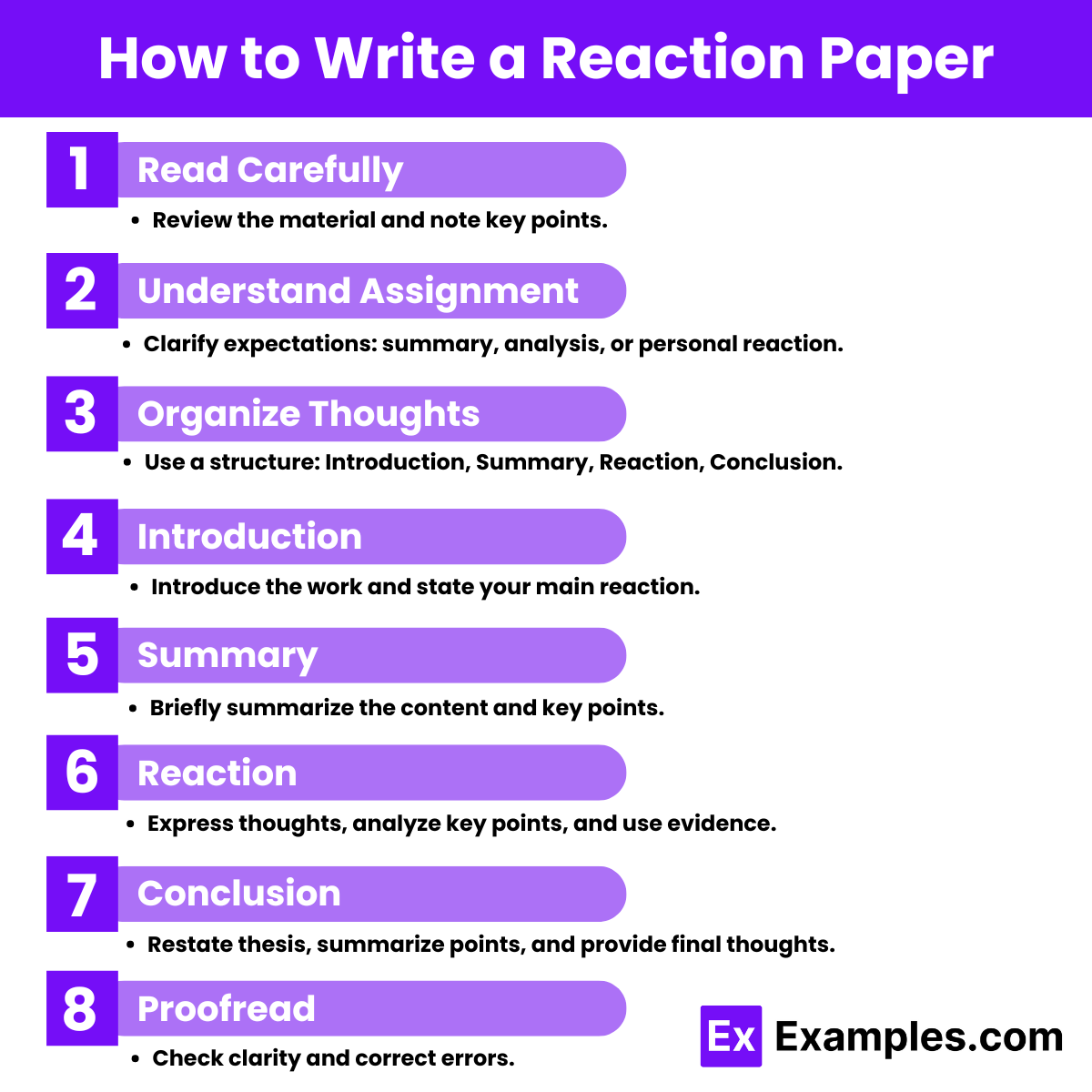
Writing a reaction paper involves expressing your personal thoughts and analyses about a particular subject, such as a book, article, film, or event. Here’s a step-by-step guide to help you write an effective reaction paper:
Understand the Assignment
Read the Guidelines: Ensure you understand the requirements, such as length, format, and specific questions or prompts.
Identify the Purpose: Know why you are writing the reaction paper. Are you summarizing and analyzing, reflecting on personal experiences, or critiquing the subject?Engage with the Subject
Read/Watch Carefully: Thoroughly engage with the material. Take notes on important points, themes, and your initial reactions.
Highlight Key Points: Identify significant elements that stand out to you, such as main arguments, themes, or memorable moments.Organize Your Thoughts
Create an Outline: Plan the structure of your paper. Typical sections include Introduction, Summary, Reaction, and Conclusion.
Identify Key Points: Decide on the main points you want to discuss in your reaction.Write the Introduction
Introduce the Subject: Briefly describe what you are reacting to (e.g., book, movie, article, event).
Provide Context: Offer any necessary background information.
State Your Thesis: Clearly state your main reaction or perspective on the subject.
Outline the Paper: Mention the key points or aspects you will discuss in your reaction.Write the Summary
Be Concise: Provide a brief summary of the subject, focusing on the main points and themes.
Stay Objective: Keep this section factual and avoid inserting personal opinions.Write the Reaction
Personal Reflection: Discuss your personal feelings and thoughts about the subject. Explain why you reacted the way you did.
Analyze Specific Elements: Dive deeper into specific elements of the subject, such as themes, characters, or events.
Use Examples: Support your reaction with specific examples from the subject. Quote or reference key moments that influenced your perspective.
Connect to Broader Themes: Relate your reaction to broader themes or relevant real-world issues.Write the Conclusion
Restate Your Thesis: Briefly restate your main reaction or thesis.
Summarize Key Points: Recap the main points you discussed in your reaction.
Final Thoughts: Offer any concluding thoughts or reflections. Discuss the broader implications or lessons learned from the subject.Proofread and Revise
Review for Clarity: Ensure your writing is clear and concise. Make sure your arguments are well-supported and logically organized.
Check Grammar and Spelling: Proofread your paper for any grammatical or spelling errors.
Seek Feedback: If possible, ask a peer or instructor to review your paper and provide feedback.Follow Formatting Guidelines
Citation Style: Use the appropriate citation style (APA, MLA, etc.) if you reference any sources.
Formatting: Ensure your paper meets the formatting requirements, such as font size, margins, and title page, as specified by your instructor.
What is a reaction paper?
A reaction paper is a written assignment where you express your thoughts, feelings, and analyses about a specific subject like a book, article, movie, or event.
How do you start a reaction paper?
Start with an engaging introduction that introduces the subject, provides context, states your thesis, and outlines the key points you’ll discuss.
What should be included in a reaction paper?
Include an introduction, summary of the subject, your personal reaction, analysis of specific elements, and a conclusion that ties everything together.
How do you write a thesis statement for a reaction paper?
Write a concise statement reflecting your main reaction or perspective on the subject, guiding the direction of your paper.
How long should a reaction paper be?
Typically, a reaction paper ranges from 2 to 5 pages, depending on the assignment requirements and depth of analysis needed.
What is the purpose of a reaction paper?
The purpose is to articulate your personal response, critically analyze the subject, and connect it to broader themes or real-world issues.
Can you use first person in a reaction paper?
Yes, using the first person is appropriate as you are expressing your personal thoughts and reactions.
What is the difference between a reaction paper and a summary?
A summary provides an objective overview of the subject, while a reaction paper includes your personal thoughts, feelings, and analysis.
How do you conclude a reaction paper?
Summarize your main points, restate your thesis in light of the analysis, and offer final reflections or implications of the subject.
What is the best way to proofread a reaction paper?
Review for clarity, coherence, and grammar errors. Consider seeking feedback from peers or using tools like grammar checkers.



